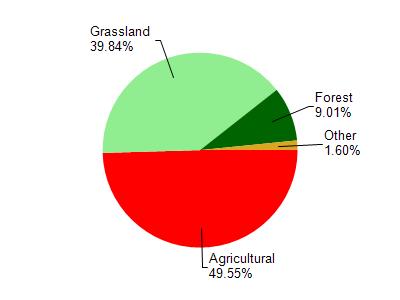Lafayette
Yes
No
No
Fish and Aquatic Life
Overview
This is a spring-fed stream of moderate gradient which flows northeasterly into the West Branch of the Pecatonica River just below the Iowa County line in Lafayette County. The entire stream is a Class II trout fishery. A baseline survey conducted in 2000 revealed the presence of brown trout and forage fish.
Date 2002
Author Aquatic Biologist
Historical Description
Jones Branch, T4N, RlE, Sections 24-5, Surface acres = 2.7, Miles = 3.2, Gradient = 15.6 feet per mile, Total alkalinity = 320, Volume of flow = 2.0 cfs.
A spring-fed stream of moderate gradient; Jones Branch flows northeasterly into the West Branch of the Pecatonica River just below the Iowa County line. There are several good springs which feed directly into the stream. Another good (0.4 cfs.) source of spring water is a spring-fed feede rwhich enters from the southwest just below the headwaters. Although natural reproduction of trout is limited, it is classified as a better than average brown trout stream. Currently, it is stocked with brown trout on an annual basis. Over three-fourths of the watershed is open agricultural land. However, much of the land area immediately adjacent to the stream is either heavily wooded or in meadow pasture. The stream banks are generally stable in the upper and middle sections and moderately eroded near the mouth. Silt is the most common bottom type at the headwaters and at the mouth, while gravel predominates in the central sections. Ducks and muskrats are present on the stream. Upland game species generally include ruffed grouse, Hungarian partridge, pheasants, squirrels, rabbits and deer. Public access is limited to one town road located about one mile above the mouth.
From: Piening, Ronald; Poff, Ronald; Threinen, C.W., 1967. Lake and Stream Classification Project. Surface Water Resources of Lafayette County, Wisconsin Department of Natural Resources, Madison, WI.
Date 1967
Author Surface Water Inventory Of Wisconsin
Condition
Wisconsin has over 84,000 miles of streams, 15,000 lakes and milllions of acres of wetlands. Assessing the condition of this vast amount of water is challenging. The state's water monitoring program uses a media-based, cross-program approach to analyze water condition. An updated monitoring strategy (2015-2020) is now available. Compliance with Clean Water Act fishable, swimmable standards are located in the Executive Summary of Water Condition in 2018. See also the 'monitoring and projects' tab.
Reports
Management Goals
Wisconsin's Water Quality Standards provide qualitative and quantitative goals for waters that are protective of Fishable, Swimmable conditions [Learn more]. Waters that do not meet water quality standards are considered impaired and restoration actions are planned and carried out until the water is once again fishable and swimmable
Management goals can include creation or implementation of a Total Maximum Daily Load analysis, a Nine Key Element Plan, or other restoration work, education and outreach and more. If specific recommendations exist for this water, they will be displayed below online.
Monitoring
Monitoring the condition of a river, stream, or lake includes gathering physical, chemical, biological, and habitat data. Comprehensive studies often gather all these parameters in great detail, while lighter assessment events will involve sampling physical, chemical and biological data such as macroinvertebrates. Aquatic macroinvertebrates and fish communities integrate watershed or catchment condition, providing great insight into overall ecosystem health. Chemical and habitat parameters tell researchers more about human induced problems including contaminated runoff, point source dischargers, or habitat issues that foster or limit the potential of aquatic communities to thrive in a given area. Wisconsin's Water Monitoring Strategy was recenty updated.
Grants and Management Projects
Monitoring Projects
| WBIC | Official Waterbody Name | Station ID | Station Name | Earliest Fieldwork Date | Latest Fieldwork Date | View Station | View Data |
|---|
| 931800 | Jones Br | 10007994 | Jones Br. Station 1 | | | Map | Data |
| 931800 | Jones Br | 10016237 | Jones Branch - Start Of Habitat Station #1 | 11/14/2000 | 11/14/2000 | Map | Data |
| 931800 | Jones Br | 10007995 | Jones Br. Station 2 (S. Of Jericho Rd) | 11/14/2000 | 10/12/2006 | Map | Data |
| 931800 | Jones Br | 10047011 | Jones Branch ~ 4390ft DS Jericho Road | | | Map | Data |
| 931800 | Jones Br | 10014323 | Jones Branch at Jericho Road | 7/8/2016 | 7/8/2016 | Map | Data |
|

Watershed Characteristics
Jones Br is located in the Upper West Branch Pecatonica River watershed which is 77.75 mi². Land use in the watershed is primarily agricultural (49.50%), grassland (39.80%) and a mix of forest (9%) and other uses (1.60%). This watershed has 184.74 stream miles, 21.81 lake acres and 293.60 wetland acres.
Nonpoint Source Characteristics
This watershed is ranked Not Available for runoff impacts on streams, Not Available for runoff impacts on lakes and High for runoff impacts on groundwater and therefore has an overall rank of High. This value can be used in ranking the watershed or individual waterbodies for grant funding under state and county programs.However, all waters are affected by diffuse pollutant sources regardless of initial water quality. Applications for specific runoff projects under state or county grant programs may be pursued. For more information, go to surface water program grants.